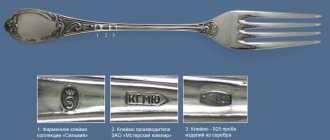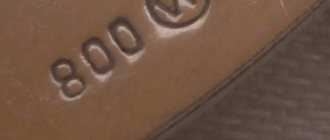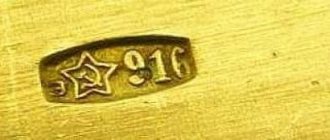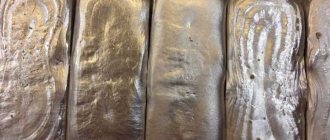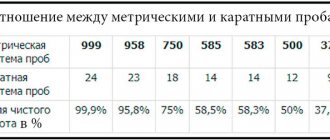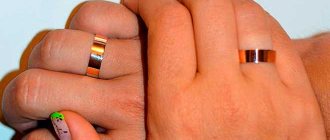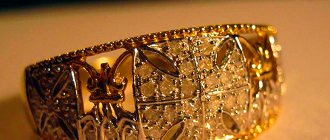Silver is the cheapest metal among those that have the right to be called precious. Silver jewelry can look elegant and noble, but be accessible to a wide range of consumers.
The situation with silverware is fundamentally different: it is not cheap, therefore a set of cutlery made from noble argentum is not available to every family. The explanation is simple: a lot of metal goes into making silver knives, spoons and forks, and production costs need to be recouped somehow.
The silverware's fineness, appearance, brand and history have a major impact on pricing. Let’s leave subjective characteristics aside and turn to the specifics, that is, the treasured numbers indicating the silver standard, and their immediate surroundings.
What are the hallmarks of silverware?
Silver is a soft metal, so its use in its pure form is limited only to the technical field and the production of measuring ingots.
In everyday life, we come across silver-based jewelry alloys: they are used to make jewelry, accessories, interior decor items and, of course, silverware.
To obtain an alloy with decent strength characteristics, so-called alloys, that is, jewelry alloys, are added to silver.
Moon metal's best friends are copper and nickel, but other additives are sometimes used. A large amount of copper determines the light yellowish tint inherent in silver “with history.”
The hallmark on cutlery is usually marked on the bottom of the handle, but variations are possible (especially on antique items). At the moment, on Russian products it reflects the content of precious metal per gram of jewelry alloy according to the generally accepted SI system. For example, 925 standard means that a kilogram of alloy contains 925 grams of silver (92.5%) - everything is simple and clear.
In Tsarist Russia, a different system of measures was adopted, the spool system, so on antique silverware you will see not three-, but two-digit numbers. The most common type is 84 sterling silver. This figure corresponds to the modern 875 sample.
By the way, almost all table silver of the Soviet era was produced from 875 alloy. Few could afford it, but the quality of these products was impeccable. Wealthy people, high-ranking officials and foreigners bought it with pleasure.
How does silverware differ from jewelry?
Table silver differs from jewelry only in the scope of application: similar alloys are used. Another thing is that for jewelry needs, high-grade alloys are more often used, while table silver can bear a mark with a modest number “800”.
The optimal jewelry alloy is the so-called “sterling silver”, 925 standard. It is used in the production of the vast majority of jewelry. But exclusive jewelry can also be of a higher standard, for example, with the “960” stamp.
The use of 925 silver in the production of cutlery is limited for obvious reasons. This alloy is quite soft, which promotes abrasion and deformation of products during operation. A fork with easily bending tines, you will agree, is not very convenient.
Cutlery set 4 pieces (go to SUNLIGHT catalog)
Nevertheless, the fairly soft 916 alloy is used to make very expensive tableware (decanters, glasses, shot glasses) and table decor items, usually with enameling. And 960 sterling silver is used exclusively for the manufacture of unique products with pronounced antiseptic properties.
However, with the advent of rhodium plating technology, the use of sterling silver in a not very familiar area has become more frequent. Now high-quality forks, spoons and knives are coated with a layer of rhodium by galvanization.
As a result of this treatment, the surface of silverware becomes more shiny, durable, and resistant to physical and chemical influences. And caring for rhodium-plated silverware is immeasurably easier.
Silver is a natural antiseptic that kills bacteria. However, rhodium plating, unfortunately, neutralizes its antiseptic properties. So if you want to feed your child with a silver spoon, it is better to choose untreated metal with the highest possible purity.
Principles of branding
The mark was applied inside or outside the product. The most popular method of applying it is mechanical. This art is a classic for jewelry workshops. Initially, hammers were used to apply it, but later a special mechanism was created for automatic branding. Special anvils were also created that made it possible to apply jewelry stamps as accurately as possible. The machines were introduced after the need for mass branding arose.
The electric spark method is carried out with the participation of electrodes. For this purpose, a special installation was made, with the help of which the print is burned out with a spark. If the brand has jumpers at the top between the outline and the badge, it means that this item was branded using the electric spark method. This method is more effective, but not all jewelry workshops and factories use it, because such an installation costs a lot of money.
For very expensive jewelry, a special laser can be used, which applies the mark very carefully. This method is not as relevant in mass production because the laser mark disappears over time. If a person has purchased such a product, then he needs to treat it more carefully, because after a while the mark will simply disappear, and it will no longer be possible to confirm that the jewelry belongs to a precious alloy.
What do the silver marks on spoons mean?
Silver is an inexpensive, but still noble metal. This means that it is subject to mandatory branding. For silver in Russia, a stamp in the shape of a lying barrel is accepted. In addition to the number indicating the content of precious metal, there is a female profile wearing a traditional Russian kokoshnik.
In addition to the mandatory hallmark, other marks may be affixed to the metal. Usually these are logos of manufacturers, brands, brands.
It is extremely difficult to understand all this diversity, and even more so if we are talking about antiques. The best option in this case is to submit the product for professional examination. The expert will indicate not only the precious metal content, weight and origin of the product, but also its estimated value.
You can, of course, experiment with homemade methods of determining the precious metal (iodine, lapis pencil, sulfur ointment and others like them), but no one can guarantee an accurate result. And there is also the risk of spoiling a valuable item: what if you received a spoon made at the Savva Morozov manufactory especially for the royal family?
Silverware produced in other countries bears the mark accepted in the country of origin. And in the Soviet Union, products made from precious metals were, as expected, decorated with a five-pointed star with a coat of arms in the center.
Marking of silver jewelry in different countries
As you know, the sampling system was adopted in the territory of the former USSR as GOST and is not subject to challenge when the question concerns authenticity. In Europe and the USA, the standard is to measure the purity of a jewelry alloy in carats, but the situation is even more interesting with antique items. In pre-revolutionary Russia there was an old sample standard - the spool, which according to modern calculations is equal to 4.26 grams with an error of foreign impurities.
By combining three different systems, we get a universal comparison table:
| Silver standard (Russia) | Spool (antique measure) | Karat (Europe and USA) |
| 800 | 77 | 19 |
| 830 | 80 | 20 |
| 875 | 84 | 21 |
| 925 | 88 | 22 |
| 960 | 92 | 23 |
Interestingly, the Russian aristocracy was not very fond of silver items above 84 spools. Firstly, smelting pure metal was very expensive, and they tried to send it strictly for jewelry miniatures. Secondly, the analogue of the current 875 standard turned out to be less demanding in terms of hygiene, so vases, plates and other utensils were often made from it.
You can also distinguish antique silver from a fake using a hallmark. Instead of the logo of the Assay Commission, pre-revolutionary items were stamped with the coat of arms of the province in which the workshop was located or, less commonly, the initials of the jeweler himself with a facsimile.
Markings on silver spoons
Silver markings vary from manufacturer to manufacturer, but an hallmark is required. However, confusion may arise: for example, in the old days, the hallmark was set not only on silver, but also on silver-plated products.
And there are simply too many alloys similar to silver to count! If products made from them were produced in the Soviet Union or Russia, they will also be stamped (of course, without the coveted numbers):
- AL – aluminum;
- MELCH – cupronickel, an alloy of copper and nickel;
- MNC – nickel silver, copper and nickel plus zinc;
- MN – monel, cupronickel with a high nickel content;
- STAINLESS – “stainless steel”, that is, stainless steel.
Naturally, such cutlery is not silver and does not represent much value.
Which spoons are valued?
First of all, sets are valued, not isolated copies. Of course, a spoon with a master's name, decorated with a monogram, also has a high cost. But not only millionaires can afford to buy them. The cost of devices is in the thousands, not millions of dollars.
In 1912, at a Christie's auction, a pair of Faberge spoons went for $8,000. The spoon, made by Fedor Ruckert, sold for $12,500.
Silverware from German jewelers is prized throughout the world. The Robbe&Berking company supplies instruments to the palaces of oil sheikhs and to the court of the Queen of Great Britain. The companies Robert Freund, Franz Schnell Halle, Herbert Zeitner became famous.
English tableware from William Suckling, Ridley&Hayes and many other craftsmen is prized. Jewelers from Denmark also became famous for their silver products.
Among the masters from Russia, the firms of the Grachev brothers, Sazikov, Ovchinnikov, Khlebnikov and, of course, Faberge are famous.
Many of them were suppliers to the imperial court. This was honorable and prestigious; usually the products of these companies were branded with a special sign.
How much do the devices of these masters cost in Europe? The prices cannot be called exorbitant. For example, a gilded spoon, the handle of which is decorated with an image of the Virgin and Child, by the famous master A. Michelsen (Denmark) is valued at $230. It was made in 1916. Prices for this master's devices range from $50 to $600 per unit.
Antique silver spoons of the 19th-18th centuries, made by famous masters, may cost a little more. For example, a set of silverware (six forks and spoons) - manufactured in 1855 - by jeweler Hippolyte Thomas in one of the online antique stores is offered for one and a half thousand dollars. The devices are decorated with the owner’s monogram and look great; their weight is more than a kilogram.
Famous world manufacturers of silverware
Antique silver is the most valued item: its value increases every year. Rare silver from famous manufacturers of the past has the highest cultural and historical value and is sold mainly in antique stores or at auctions.
Nevertheless, even now you can buy luxurious silverware from both Russian (Veliky Ustyug, the famous Argenta, Kostroma Jewelry Factory) and foreign (British Royal Buckingham, German Robbe & Berking and Koch & Bergfeld) manufacturers. Yes, it’s not cheap, but it’s a smart investment: luxury silverware will only become more expensive from year to year!
18.08.21
Determining the authenticity of silver products
The variety of marks on antique objects makes it difficult to determine the sample. If in Great Britain and Germany the hallmark system was legally regulated for centuries, then the creations of Italian jewelers are very difficult to identify, since mandatory marking began to be used in the country only in 1870.
It is possible to determine the authenticity of silver at home. One of the properties of metal is high thermal conductivity, so a piece of ice placed on an object quickly melts. They also check the material by sound - to do this, you need to knock on the dubious product with a silver coin. The purity of the sound will indicate authenticity.
One of the common counterfeiting techniques is transferring the sample to an object using soldering. The joints are masked by blackening or engraving. In this case, only a professional with experience and the necessary equipment can determine the authenticity of the product.
The history of stamps is quite well studied. Signs and places where markings were applied changed over different time periods, so identifying the product does not cause difficulties for specialists. Very Important Lot auction catalogs contain items that have been pre-screened by experts. In the lot cards you will find a detailed description of antique silver products - jewelry, dishes, toiletries and elegant small items.
Recommendations for care, cleaning and storage
The technology for caring for and cleaning silver is the same as for gold: we wear it carefully, take it off before running a hundred meters, do not store it mixed with other jewelry, rinse it with soapy water, polish it with a cloth, do not use abrasives.
Special attention is required to blackened silver and to products with stones. An acidic environment, ammonia and soda are contraindicated for them. If the jewelry is set not with stones, but with amber, corals or pearls, then it is better to refuse to clean it yourself and take the item to a workshop.
